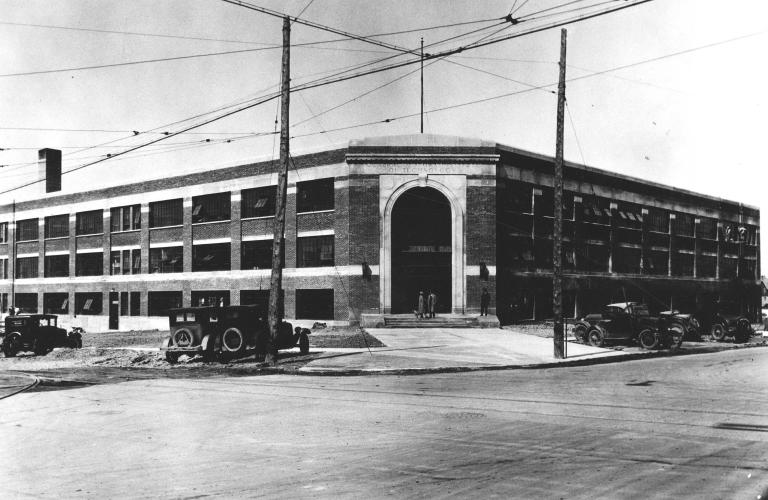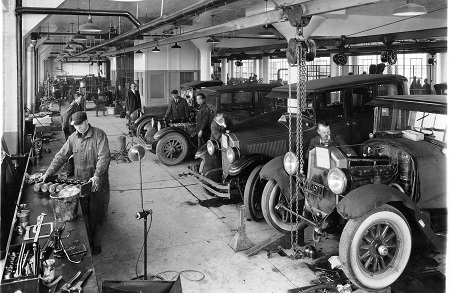
In a century, Kettering University has grown from a humble evening school in Flint, Michigan, to a national leader in STEM and business. Remarkably, the educational model has had an important constant for much of the institution’s history: cooperative education.
What is now Kettering University was founded in 1919 by Major Albert Sobey when he took over the night school that the Industrial Fellowship League ran with the YMCA. In 1924, he launched the Cooperative Engineering Program with 20 students. The students learned how to become mechanics for Buick in the early days until General Motors agreed to take over the institution in 1926. The ‘20s and ‘30s saw expansion and growth. More than 11,000 students were enrolled in the late 1930s.

A major shift for GMI was the creation of a degree program in 1945. The Army wouldn’t accept GMI students during the war, making GMI’s leaders realize they needed the degrees, said Tim Troupe Noonan, an author who is writing a book on Kettering University’s history set to be released in October 2019. Eighteen men graduated with the first degrees on August 23, 1946.
In the '50s and '60s, GMI continued to evolve. Electrical engineering was added as a major. GMI dropped 53 outdated courses and added 70 new ones, along with an optional fifth year for students. Co-ops became a standard six weeks. The University established faculty committees and took a more active role in planning curricula. Alumni wanted a way to connect, and the Alumni Association was born.
Presidents Guy R. Cowing and Harold P. Rodes made moves to update the Academic Building with modern equipment and new lab space, and in the mid-1960s, Rodes started the process of building campus on 34 acres. By 1969, the GMI campus featured the Campus Center, Thompson Residence Hall, and a parking deck, which no longer exists.
The Divestment
In 1974, General Motors gave the institute a directive to cut the program by a third, which meant reducing the student body by 1,000 students. That was the writing on the wall about GM’s involvement with GMI, Noonan said.
By 1981, a GM task force recommended the company drop GMI within two years. Although there were ideas to phase out GMI or transition it into either the University of Michigan or Michigan State University, GMI President William B. Cottingham and Trustee William McKinnon made a presentation to GM leaders to make the institution its own school. General Motors Vice President David Collier also wanted GMI to be independent. GM provided a $24.6 million transitional grant during a three-year period, and GMI Engineering and Management Institute stood on its own.
Part of the challenge for GMI was expanding its co-op program.
“If there’s a business with one client and that client goes away, nine times out of 10 the business will fold. But GMI found other partners,” Noonan said.
Bob Nichols, now Kettering University FIRST Robotics Community Center Director, recruited companies to join GMI-EMI’s co-op program in the early ‘80s.
“We worked really, really hard to come up with employers. If we found alumni with companies outside GM, we didn’t have to sell the program to them. We just convinced them to take students,” he said. “It took us a long time to get to where we are today.”
Kettering University now has more than 500 co-op partners worldwide.
Kettering President Dr. Robert K. McMahan attributes GMI’s survival and subsequent success to the leadership of the University administration, Board of Trustees, and dedicated faculty and staff.
“There were a lot of people passionate about the model of education and its relevance. The University had the people it needed at the time it needed,” he said.
Diana Tremblay ‘82, a former Board of Trustees Vice President, was a student in the late ‘70s and early ‘80s. Despite the changes and the institution losing its brand, the best elements about GMI remained, she said. GMI-EMI maintained a quality education, co-op, small classes, professors, and an intense program with a lot of great bonds.
“When I went, you didn’t go for the campus experience. There were a couple buildings: the dorm, the Campus Center, and the Academic Building. The gym was in the basement. There wasn’t even the rec center,” she said. “When I think it about now, there’s a much more rewarding campus experience.”
The 1990s and Kettering University
The ‘90s was another decade of growth for GMI, with more major changes on the horizon. The ‘90s saw the construction of the Recreation Center, C.S. Mott Engineering and Science Center, Campus Village Apartments, and 25-acre outdoor sport complex, Harris Fields, among other things. Several labs were installed, including the Kettering University Crash Safety Center, Bosch Automotive Electronic Systems Laboratory, Ford Design Simulation Studio, and the PACE Lab for e-design and e-manufacturing.
In 1997, President James John and the Board made the decision to leave behind the GMI name after more than 70 years and rename the institution Kettering University after Sobey’s friend, the GMI supporter, businessman, and inventor, Charles F. Kettering. Provost and Vice President for Academic Affairs John Lorenz believed the designation as a university would be more significant than an institute.
Kettering University was the final of the institution's seven names. Despite the changes, the heart and soul of the university remains, McMahan said.
“Alumni of GMI would recognize the experience of students today,” he said.
While some alumni lost connection with Kettering because of the name change, McMahan has done a great job reconnecting with the University’s heritage and history, Tremblay said. The GMI brand had a lot of strength at the time.
Expanding the sciences and business
From 2005 to 2011, the University expanded its academic offerings with new or restructured degree programs, minors, and areas of concentration including Pre-med, Bioinformatics, Engineering Physics, Chemical Engineering, and Business. Kettering launched and expanded the MBA program during this time.
When Tremblay was a student, there were four majors: Electrical Engineering, Industrial Engineering, Industrial Administration, and Mechanical Engineering. Now Kettering has 12 undergraduate majors and is continuing to evolve to meet the needs of a technology-infused and rapidly changing society, whether in the automotive industry or in science and business.
The preparation from the experiential learning, however, has stayed consistent.
“As a GM executive, I’d see lots of students coming through. Students from Kettering were a step apart because they had real life experiences,” Tremblay said.
In 2015, construction started on the Kettering University GM Mobility Research Center (MRC) on campus. The outdoor lab space and proving ground is used to enhance research and development of autonomous vehicles, vehicle safety standards, and hybrid and electric vehicle technologies. The center was completed in 2017, and the Harris Mobility Research Annex was constructed in 2018 to provide office and lab space on the proving ground.
Kettering University adopted Community Vitality to its Pillars of Excellence in 2011 and began its work to be a good neighbor and strong leader in Flint.
The University is a leader in transforming Flint into a safer, more walkable, and more vibrant city with ongoing blight removal and beautification along University Avenue. Kettering took ownership of and renovated the historic Atwood Stadium in 2014. Students contribute to the community with Service Saturdays and projects with area organizations such as the Flint River Watershed Coalition and Habitat for Humanity.
The efforts continue with new community events at Atwood Stadium and new businesses along University Avenue.
The Next Chapter
Kettering is expanding on-campus access to the arts. The Jane Boon '90 and Norman Pearlstine Music Studio and Practice Rooms in the Campus Center are a first step in this direction.
“The A in STEAM has been present on campus. Even when I was a student, it was there,” Boon said. “There’s always been a curiosity and hunger for arts programming on campus.”
Arts introduce a sense of fun and play to engineering, Boon said, and that’s increasingly valued at workplaces. There are classic tools to overcome writer’s block that are very relevant to product development that individuals can use to boost their technological and engineering efforts. The more engineers become aware of tools of other disciplines, the better they become, she said.
Kettering remains committed to growing its science programs in the College of Sciences and Liberal Arts. Newly added to the academic program, course clusters allow interested students to study sustainability (GREEN), pre-med and health (K-HEAL), Artificial Intelligence and Robotics with courses and electives tailored to those topics. The pre-med program is growing through a club, and students with degrees in engineering are going on to become physicians and surgeons.
With more than 50 clubs and organizations, students are applying their knowledge and love of computer science, computer engineering, business, biology, chemistry, and mechanical and electrical engineering to projects in the Flint community and beyond.
Mobility remains a steadfast focus of the University despite the rapidly-changing industry. Electric motors, connected and autonomous vehicles are replacing the combustion engines of the past 100 years. Alumni such as General Motors CEO Mary Barra ‘85, GM Chief Engineer of Autonomous Vehicles Mandi Damman ‘07, President and CEO of the Center for Automotive Research Carla Bailo ‘83, and Senior Vice President and Chief Technology Officer for Delphi Technologies Mary Gustanski ‘85 are leaders in world of mobility.
The MRC makes Kettering a location for companies such as Delphi Technologies to test new technology and for students to pioneer that technology in competitions such as SAE AutoDrive Challenge and Formula SAE.
Boon noted the increased diversity of the student body and academic programs in the past three decades.
The single-mindedness and commonality of the experience made for a specific, but atypical university experience, she noted of her time at GMI. The new incarnation of the school offers a wider breadth of intellectual offerings and a commitment to the community, she said.
“You’re not hemmed in by opportunities in the auto industry. You have everything at your disposal,” Boon said. “There’s also a hunger for meaning in the intellectual pursuits. There was a great ambition when I was a student, but I don’t remember as much drive toward meaning. I think that’s exciting.”